Tools Required
| • | J 41742 Connecting Rod Guide |
| • | J 44057 Crankshaft Tie Plate Socket |
| • | SA9142E Piston Ring Compressor |
- Dowel pins are installed until they bottom out in the cylinder block.
- Install the dowel pins using a brass driver.
- Install the main bearings.
- Install the thrust bearing in the number 3 upper main bearing position of the block.
- Place crankshaft in cylinder block and coat with engine oil.
- Install the main bearing caps.
- Install the bearing caps in their proper locations. The arrow on the bearing cap points toward front of the cylinder block.
- Using a rubber mallet, rap the crankshaft rearward, then forward in the cylinder block to align the thrust bearing.
- Apply a light coat of engine oil on the threads and under the heads of the cap bolts.
- Install and uniformly tighten the 10 cap bolts in several passes, in the sequence shown.
- Check that the crankshaft turns smoothly.
- Check the crankshaft thrust clearance.
- Install piston and connecting rod assemblies:
- Install the J 41742 to connecting rod bolt holes. The guides are required to prevent damage to the crankshaft rod journals. Install the upper connecting rod bearings and coat with oil, if not completed previously.
- Using the SA9142E Piston Ring Compressor, push the correct piston and connecting rod assembly into each cylinder with the two eyebrow cuts on the piston facing toward the intake manifold side of engine block.
- Verify the proper piston pin orientations by looking at the underside of the pistons. Ensure the piston pin boss with the rectangular-shape casting feature is pointing toward the back of the engine.
- Install the connecting rod caps:
- Connecting rod serial numbers are located as illustrated.
- Match the serial number of the cap with the serial number of the connecting rod.
- Install the lower connecting rod bearing in the cap. Apply a light coat of oil on the bearing surface.
- Install the cap with the bearing tang slots in the cap and connecting rod facing each other.
- Install and alternately tighten the cap bolts in several passes.
- Check that the crankshaft turns smoothly.
- Check the connecting rod side clearance.
- Install the rear oil seal assembly if required:
- Ensure that the surface is free of RTV and it clean with a chlorinated solvent, such as carburetor spray cleaner, brake clean, or alcohol Saturn P/N 21007432 or equivalent.
- Install a 5 mm (0.2 in) diameter bead of RTV on the rear seal carrier.
- Install the 4 rear crankshaft seal assembly bolts.
- Refer to the appropriate SOHC or DOHC cylinder head procedures in this section for cylinder head and front cover installation.
- Install the crankshaft bearing tie plate (DOHC [LL0]) and oil pickup tube with a new O-ring.
- Install the crankshaft bearing tie-plate over the main bearing cap studs.
- Install the 6 crankshaft bearing tie-plate fasteners to the oil pan rail on the engine block.
- Install the tie-plate inserts. Rotate the inserts clockwise to bring the inserts into contact with the bearing cap studs. Use the J 44057
- Tie Plate Insert torque sequence:
- Install washers over the bearing cap studs onto the inserts.
- Install the ten nuts to the bearing cap studs.
- Install the oil pickup tube.
- Install the oil pan assembly and fasteners.
- Ensure the oil pan surface is free of cured RTV and cleaned with a chlorinated solvent, such as carburetor spray cleaner, brake clean, or alcohol Saturn P/N 21007432 or equivalent.
- Apply a 4 mm (0.16 in) bead of RTV in the oil pan groove, routing the RTV bead toward the inside of all bolt holes.
- Install water pump:
- Install the dipstick tube with a new O-ring. Lubricate the O-ring with engine oil and install it into the cylinder block. Attach the tube bracket to the cylinder block.
- Install the flexplate or flywheel. The flexplate and flywheel can be installed at any bolt hole location. The flexplate or flywheel can be held with a flywheel turning tool when torquing the bolts.
- Install the following accessories:
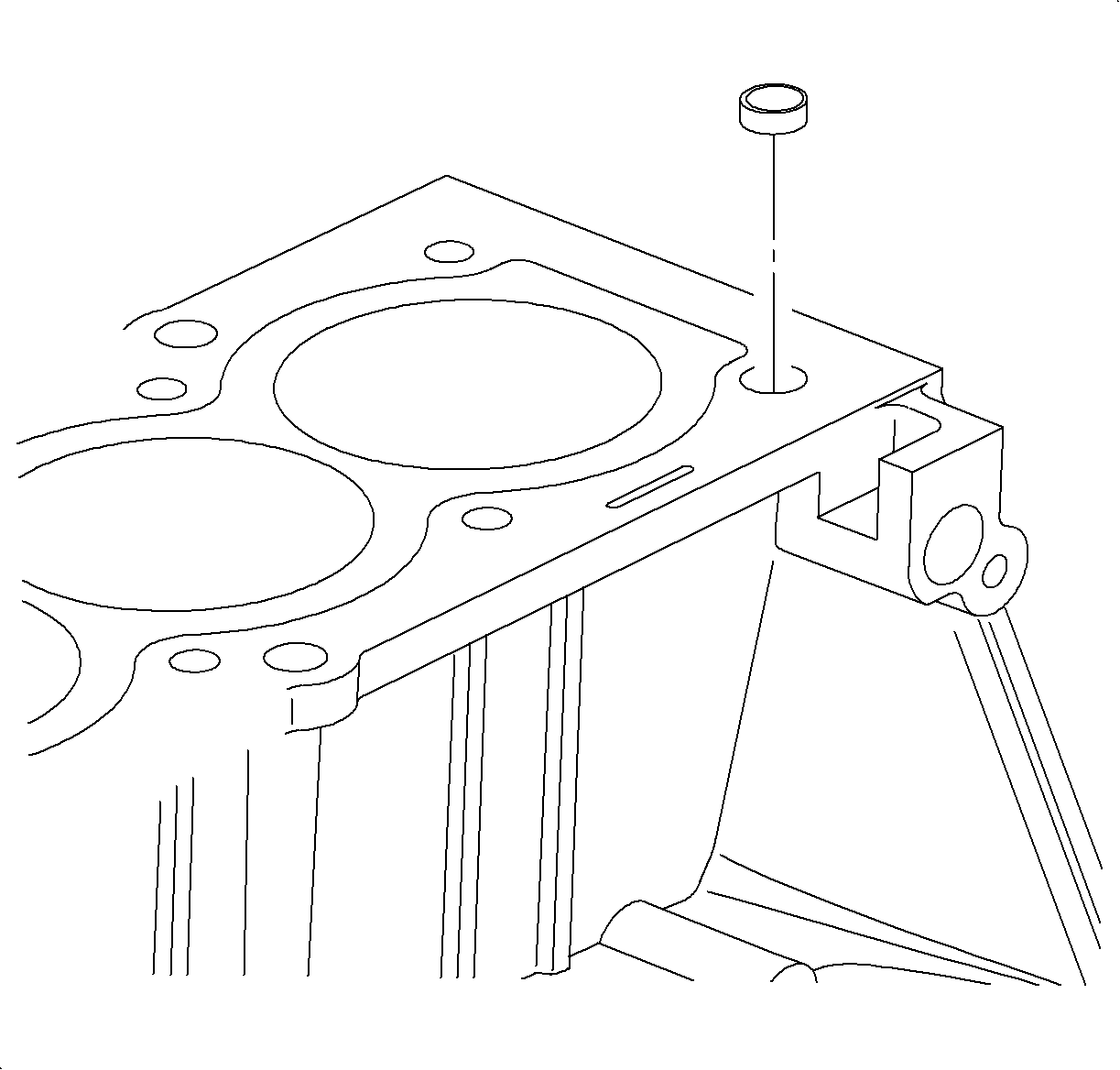
Important:
• The engine block requires the location dowel pins for the front cover,
cylinder head, rear crankshaft seal carrier, and transaxle be installed with a brass
driver. Dowel pins are installed until they bottom out in the cylinder block. • Thoroughly clean all parts to be assembled. Honed cylinders must be scrubbed
with a solution of Tide® powdered laundry detergent, or equivalent and high
pressure warm water prior to piston assembly. Before installing the parts, apply
new engine oil to all sliding and rotating surfaces. Replace all gaskets, O-rings,
and oil seals with new parts.
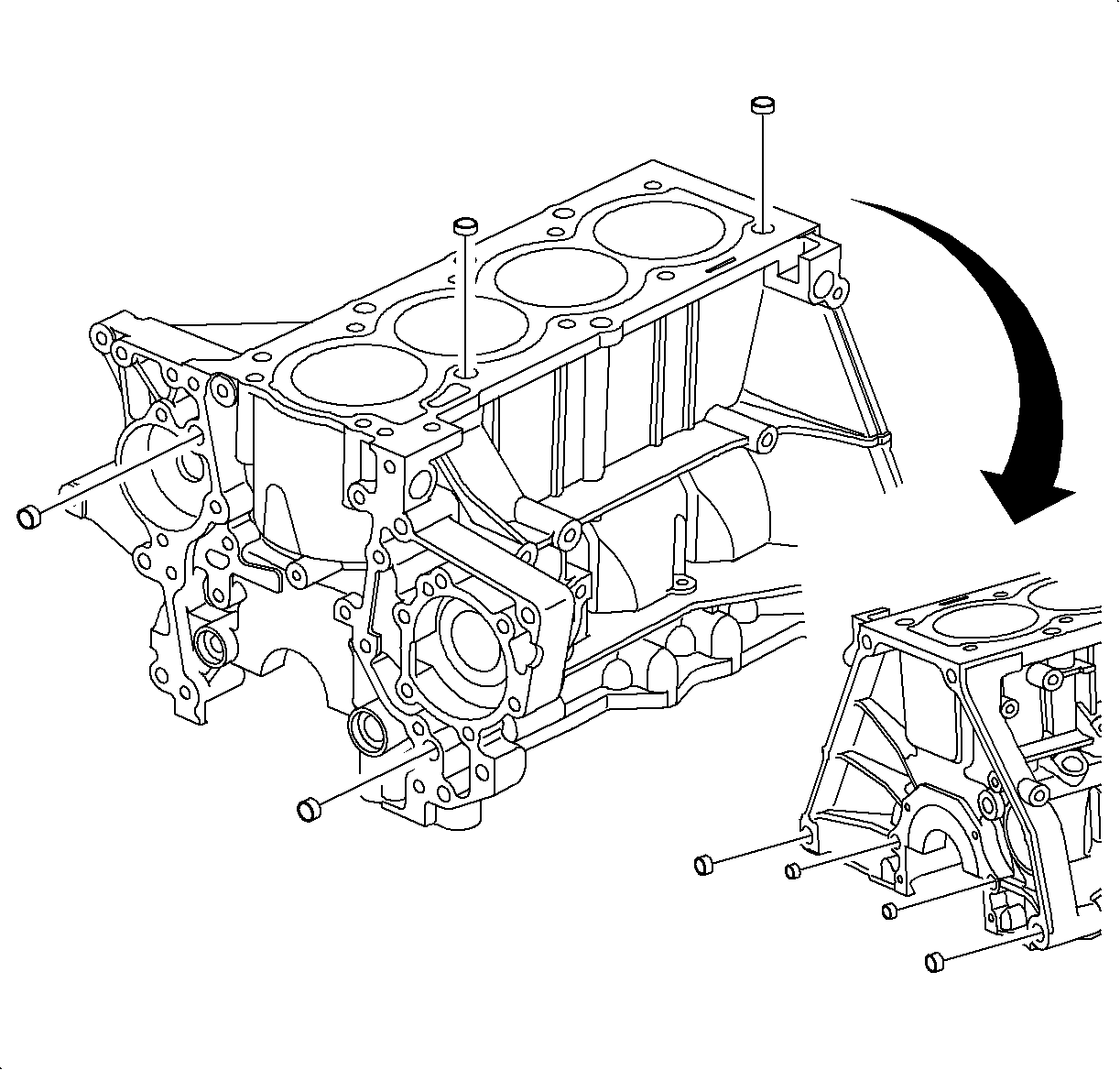
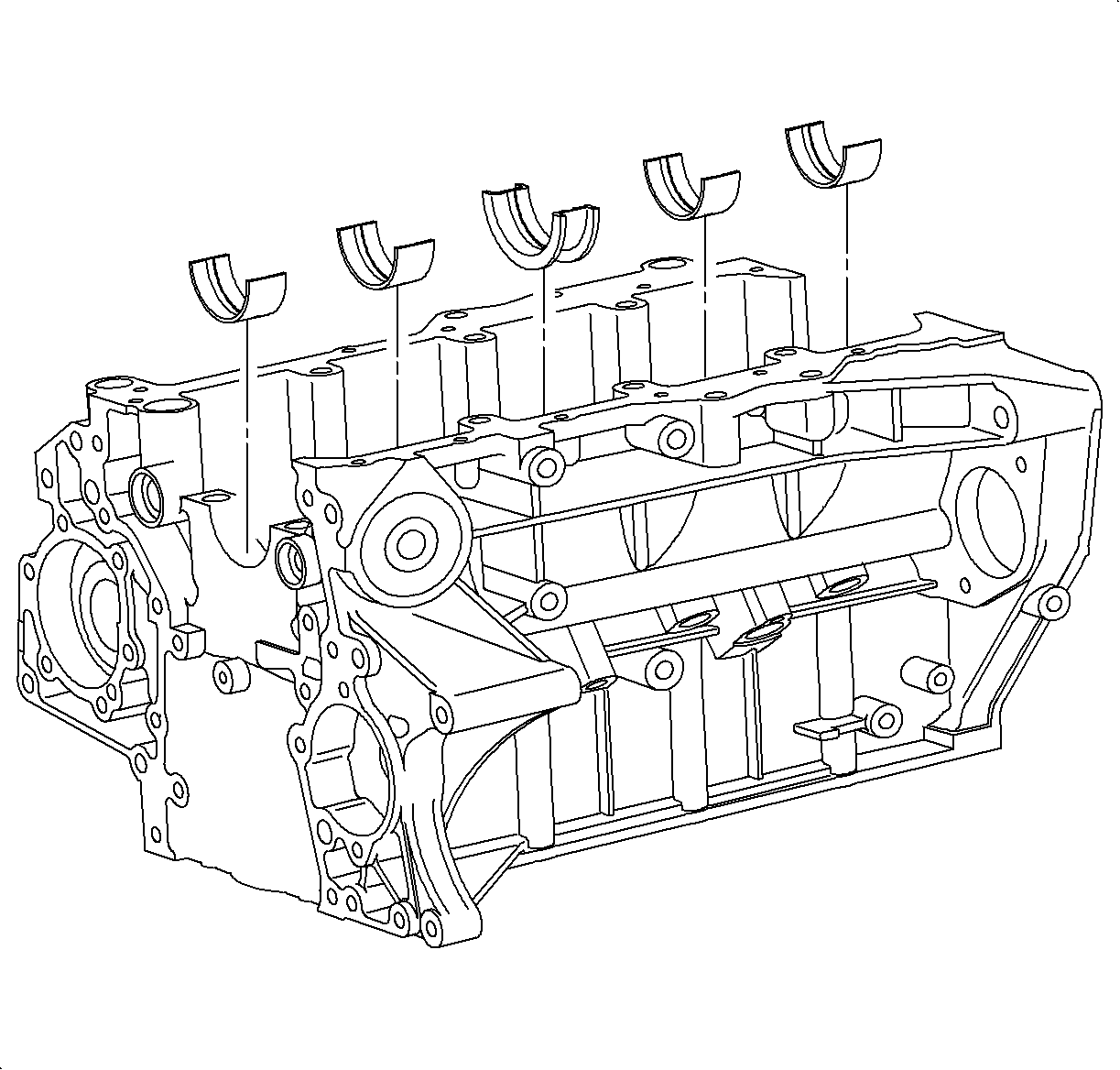
Important: Install the bearings with the oil holes in the block. The bearings with no holes must go in the main bearing caps.
Install the bearings in the cylinder block and the bearing caps.
Important: Inspect the alignment of the bearing oil hole to the block bulkhead oil feed hole. At least 50 percent of the feed hole must be open/exposed.
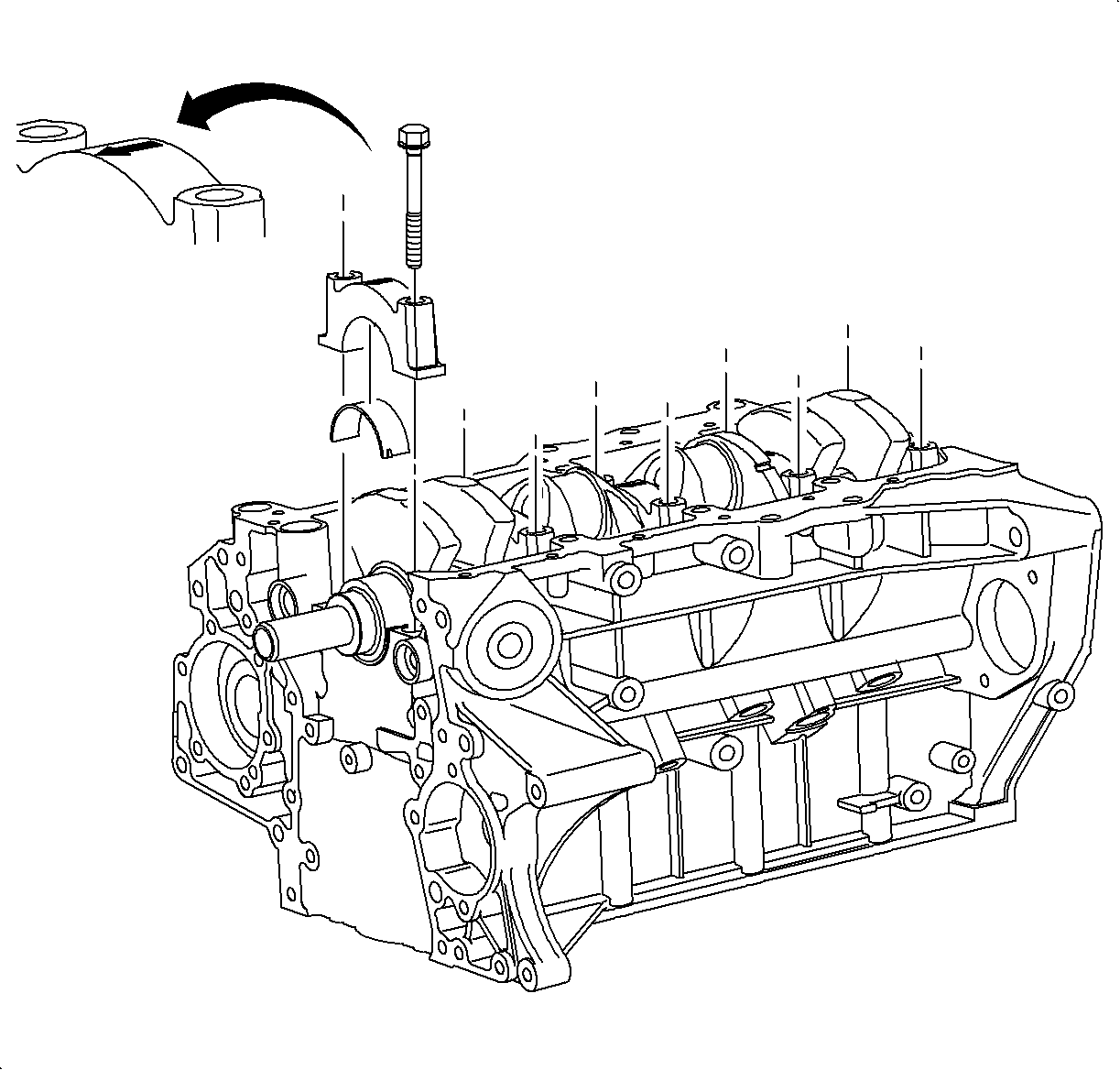
Important: The bearing caps are numbered 1-5 and have an arrow that points toward the front of the engine. No. 1 cap is at the front of the cylinder block.
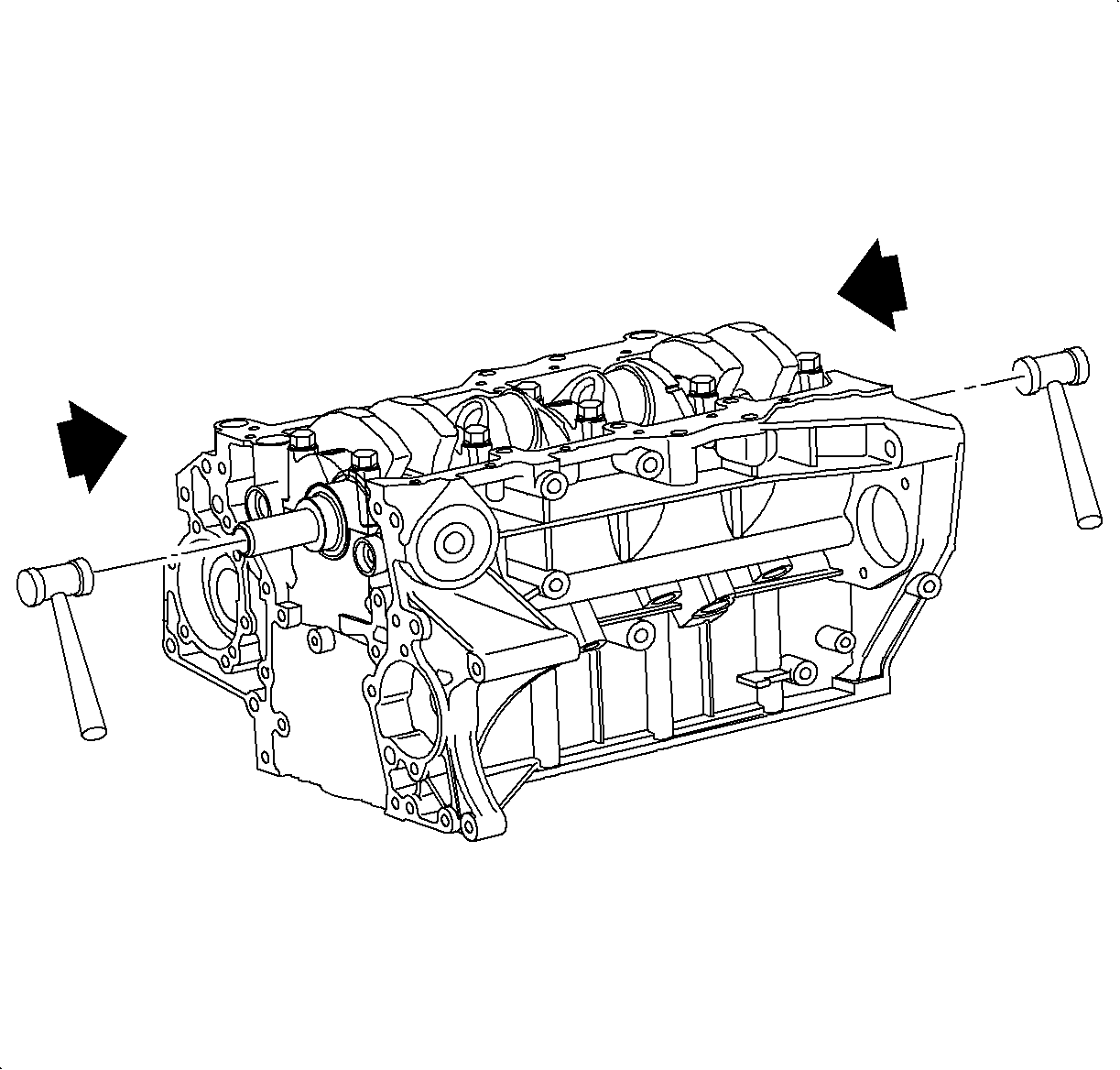
Important: Use a rubber mallet and rap the crankshaft rearward, and forward in the cylinder block to ensure the thrust bearing is properly aligned.
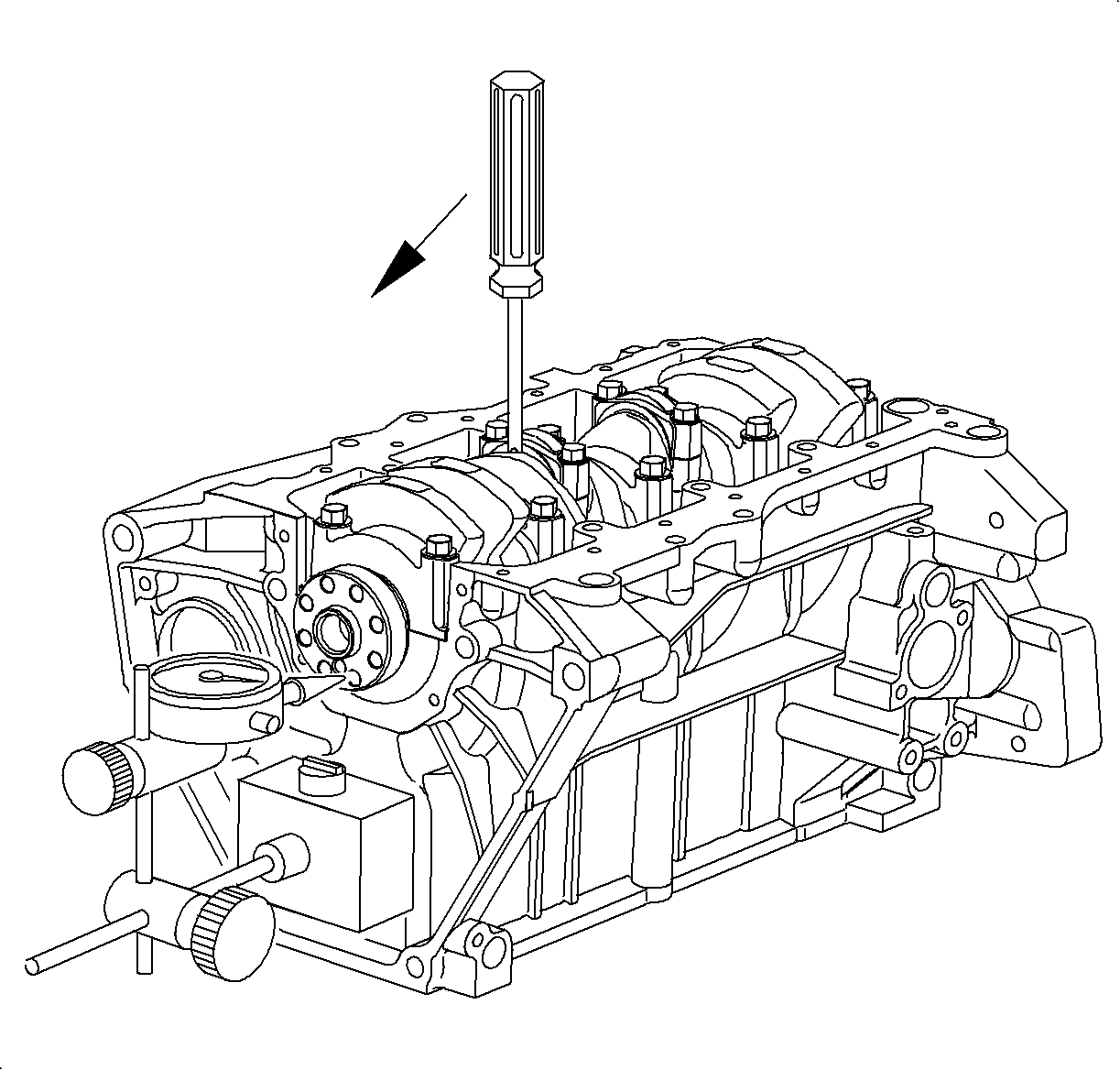
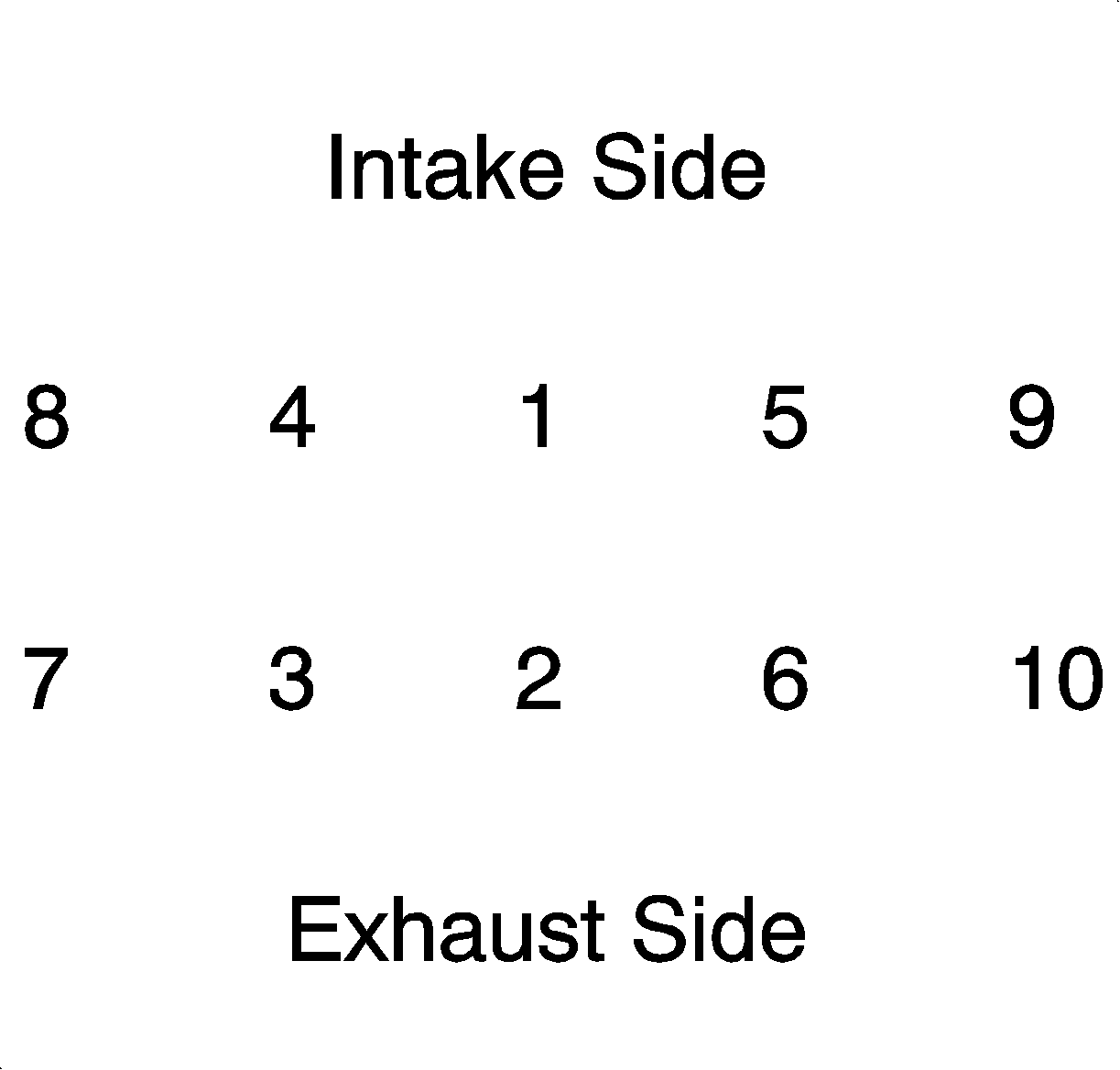
Tighten
Tighten the Crankshaft Bearing Cap-to-Block 50 N·m (37 lbs ft).
Thrust Clearance
| • | Standard: 0.05-0.2 mm (0.002-0.0089 in) |
| • | Service Limit: 0.25 mm (0.0098 in) |
| • | If the clearance is greater than maximum, replace the thrust bearing. |
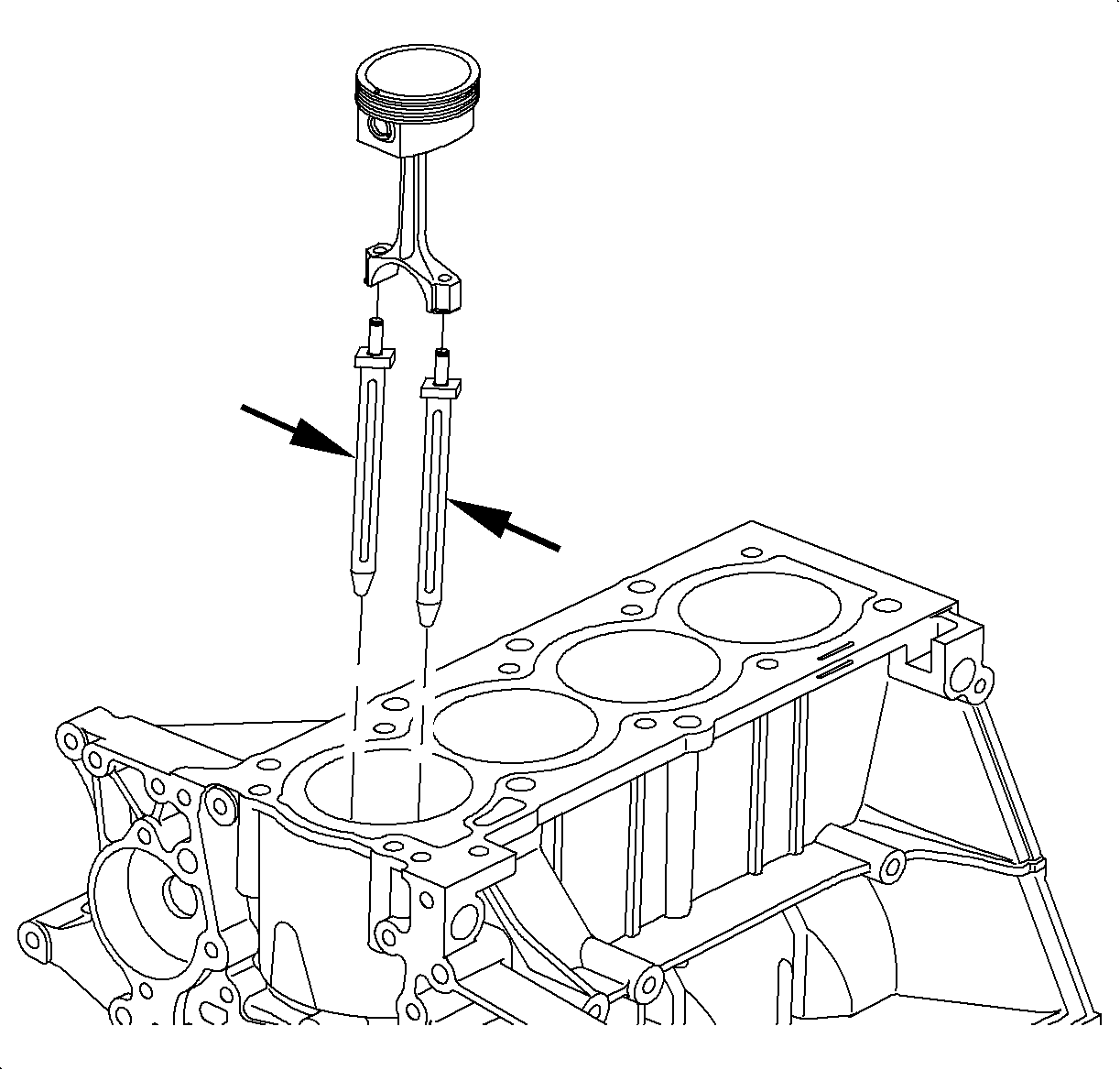
Important:
• If the crankshaft does not turn smoothly, remove the bearing caps one
at a time until the tight bearing is found. Check crankshaft journal dimensions and
replace bearings (upper and lower) as necessary. • If a new crankshaft is installed, the PCM will be required to learn the
reluctor ring notch location of the new crankshaft. Refer to "Crankshaft Position
Variation Lean Procedure" under DTC P1336 in the Engine/Emission section
of this service manual. • Do not pull pistons down through the cylinder bores beyond their normal
travel.
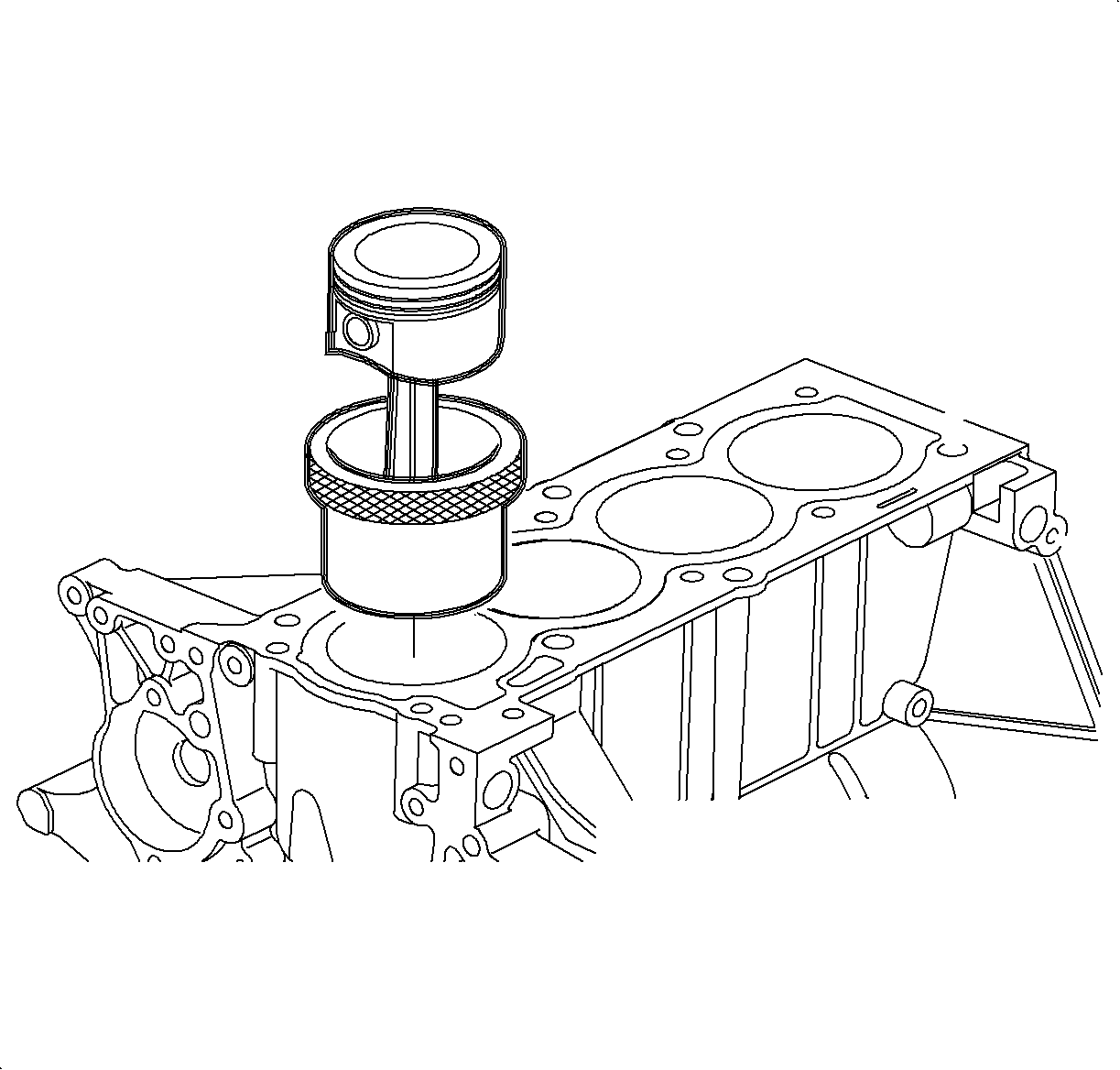
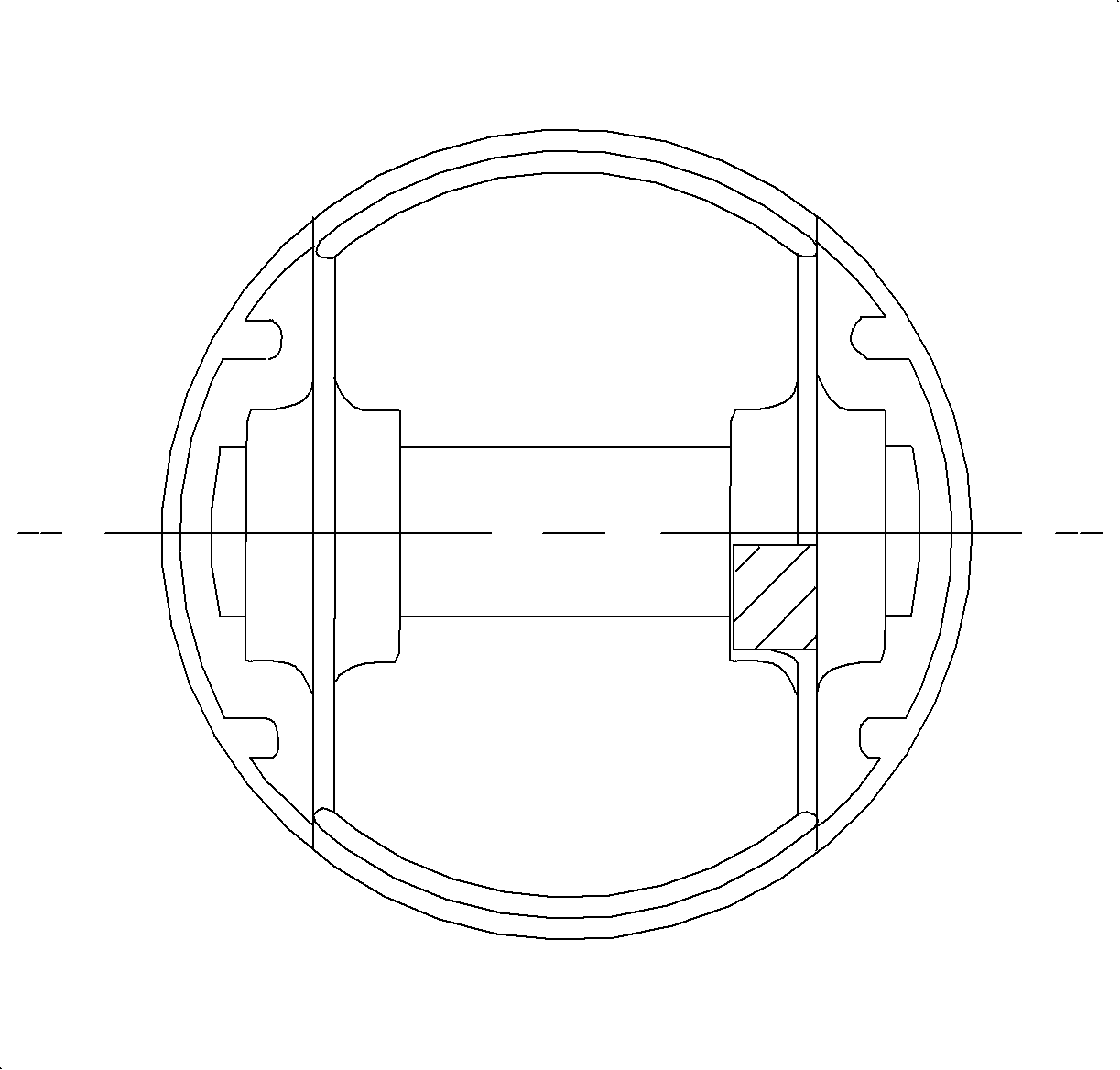
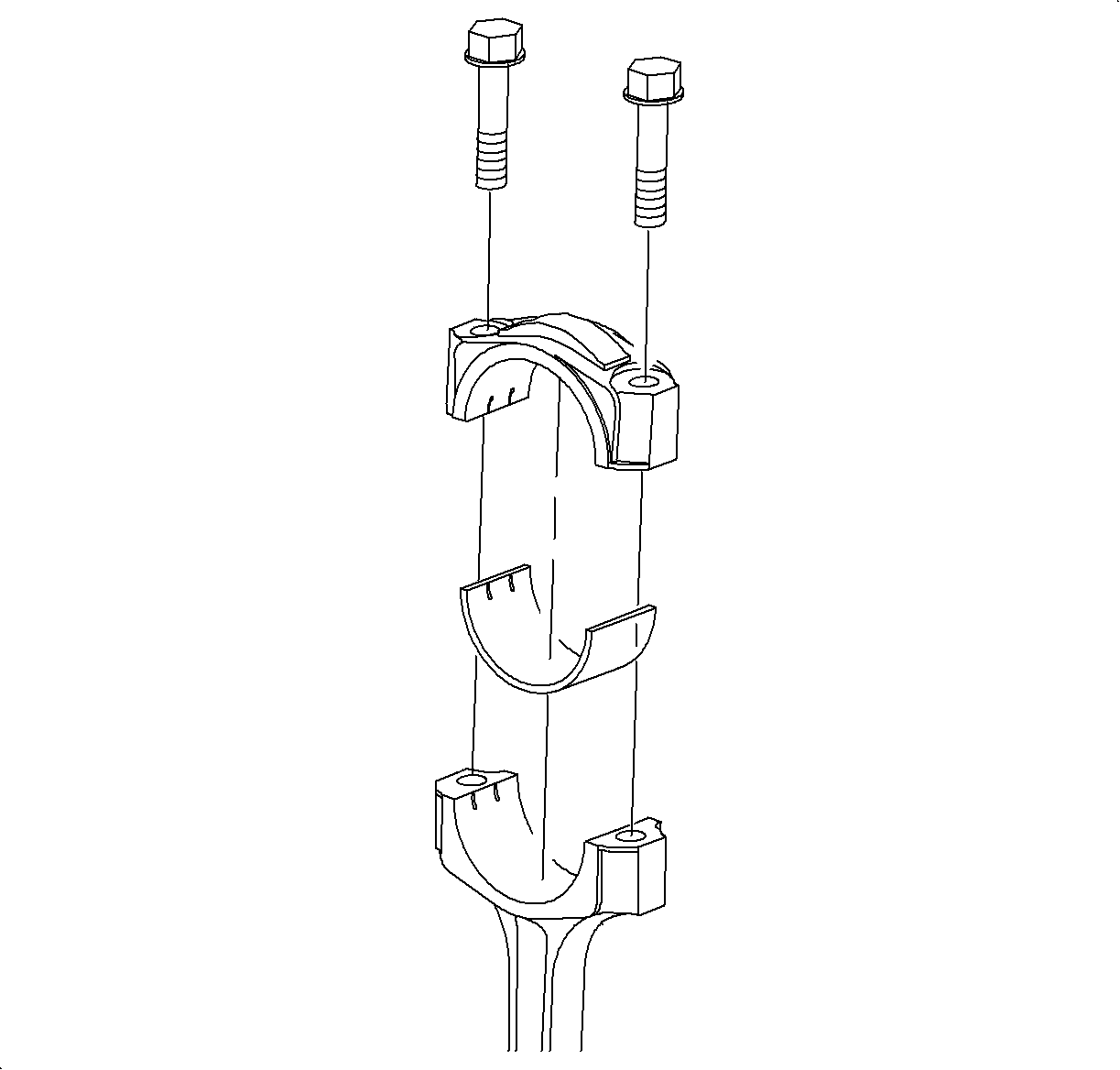
Important:
• The powdered metal connecting rod and cap are machined for the proper
clearances. The connecting rod and cap must be used as an assembly with no repair
or modifications to either mating surface. Do not attempt to repair the connecting rod or the cap mating surfaces. If service
is required, the connecting rod and cap must be replaced as an assembly. • Use extreme care when installing the piston and connecting rod. The connecting
rod must be properly aligned with the crank pin to prevent journal damage. It is
standard practice to assemble the piston and connecting rod with bearing tang slots
in the rod directed toward the exhaust manifold side.
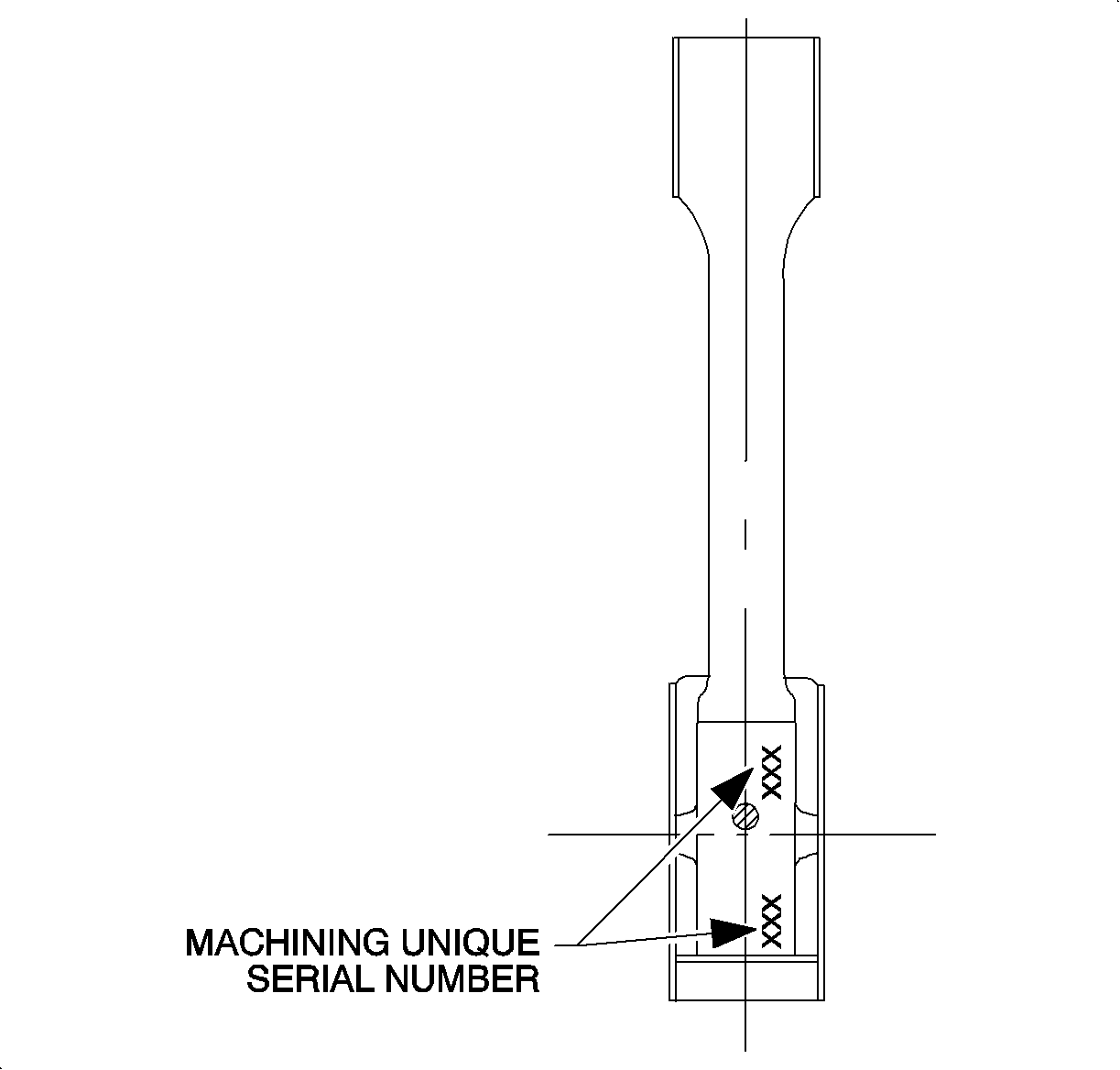
Important: Connecting rods and rod caps which are assembled properly will have matching serial numbers located as illustrated.
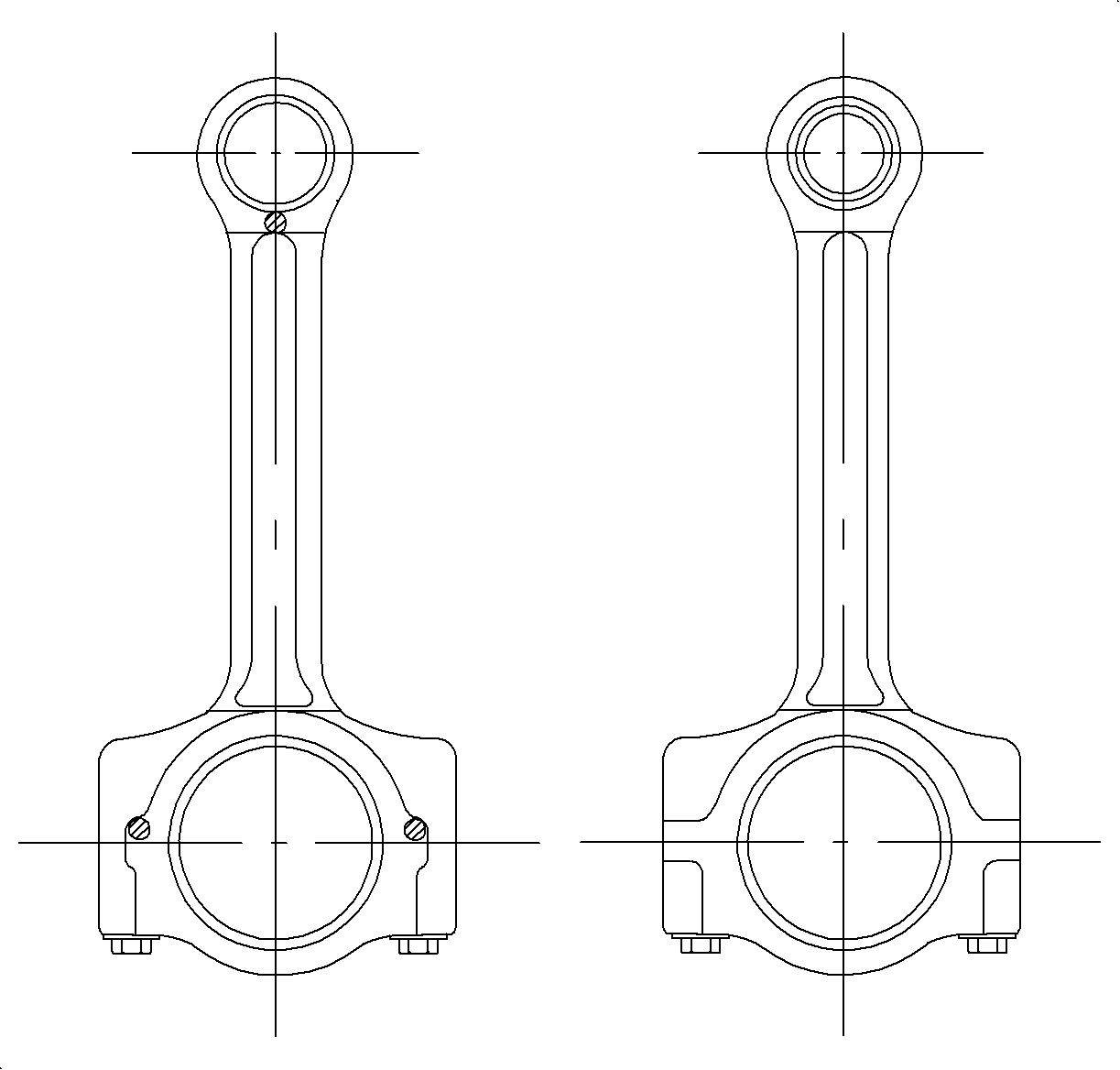
Important: The large end of the connecting rod will have machined surfaces that appear as illustrated when properly assembled.
Important: The cap and rod tangs are located on the same side of the connecting rod bore.
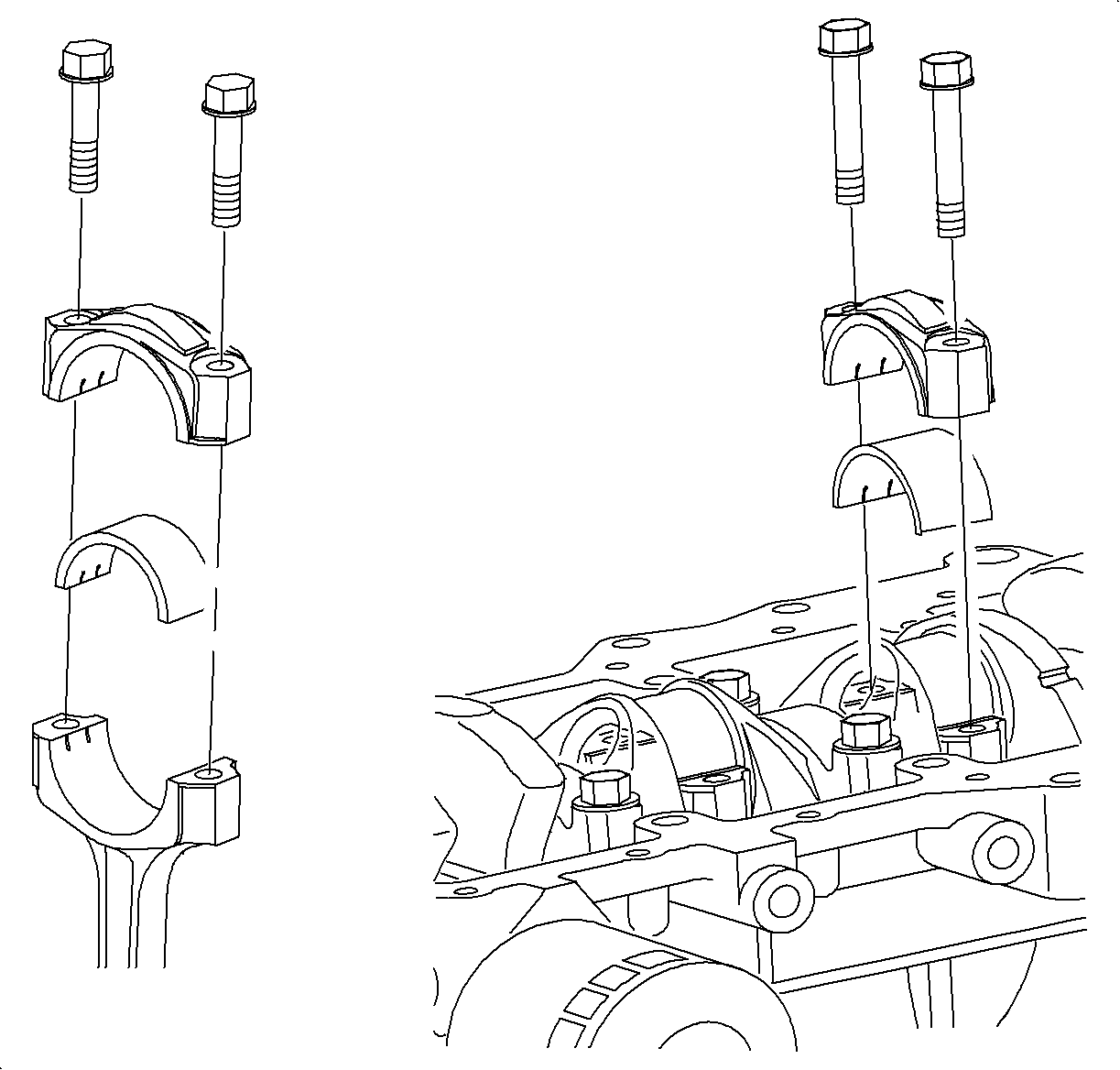
Important: The machined slots in the rod and cap must be properly aligned to prevent bearing damage.
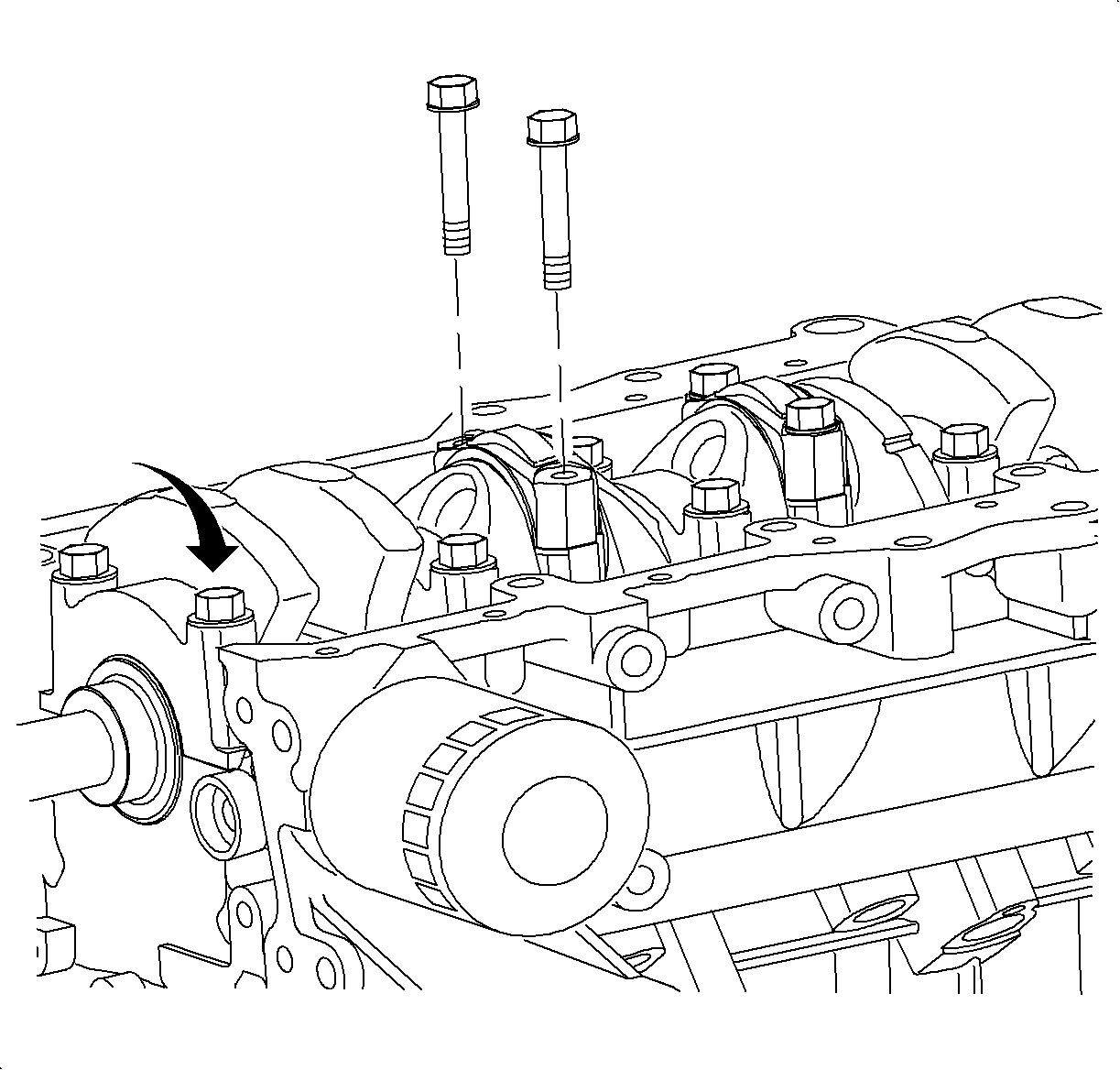
Important: The connecting rod bolts are torque-to-yield fasteners. The number of times the bolts can be used is limited. New bolts, which have never been tightened, must be used when the connecting rod and rod cap are final assembled in the engine.
Tighten
Tighten the connecting rod cap-to-rod to 25 N·m (19 lb ft)+75 degrees.
Notice: Check the oil seal lip contact surface of the crankshaft for scratches or damage. If rust is present, remove with a Scotch-Brite® pad or equivalent. Do not use emery cloth, sandpaper, or other abrasive materials. Rust removal is necessary to prevent seal lip damage during installation.
Side Clearance
| • | Standard: 0.165-0.435 mm (0.0065-0.1713 in) |
| • | Service Limit: 0.47 mm (0.185 in) max |
| • | If clearance is less or greater than maximum, replace the connecting rod assembly. If necessary, replace the crankshaft. |
Piston Protrusion Below Deck of Block
| • | Standard: 0.066 mm (0.0026 in) max |
| • | Service Limit: 0.145 mm (0.0057 in) max |
Piston Protrusion Above Deck of Block
| • | Standard: 0.3 mm (0.0118 in) max |
| • | Service Limit: 0.379 mm (0.0149 in) max |
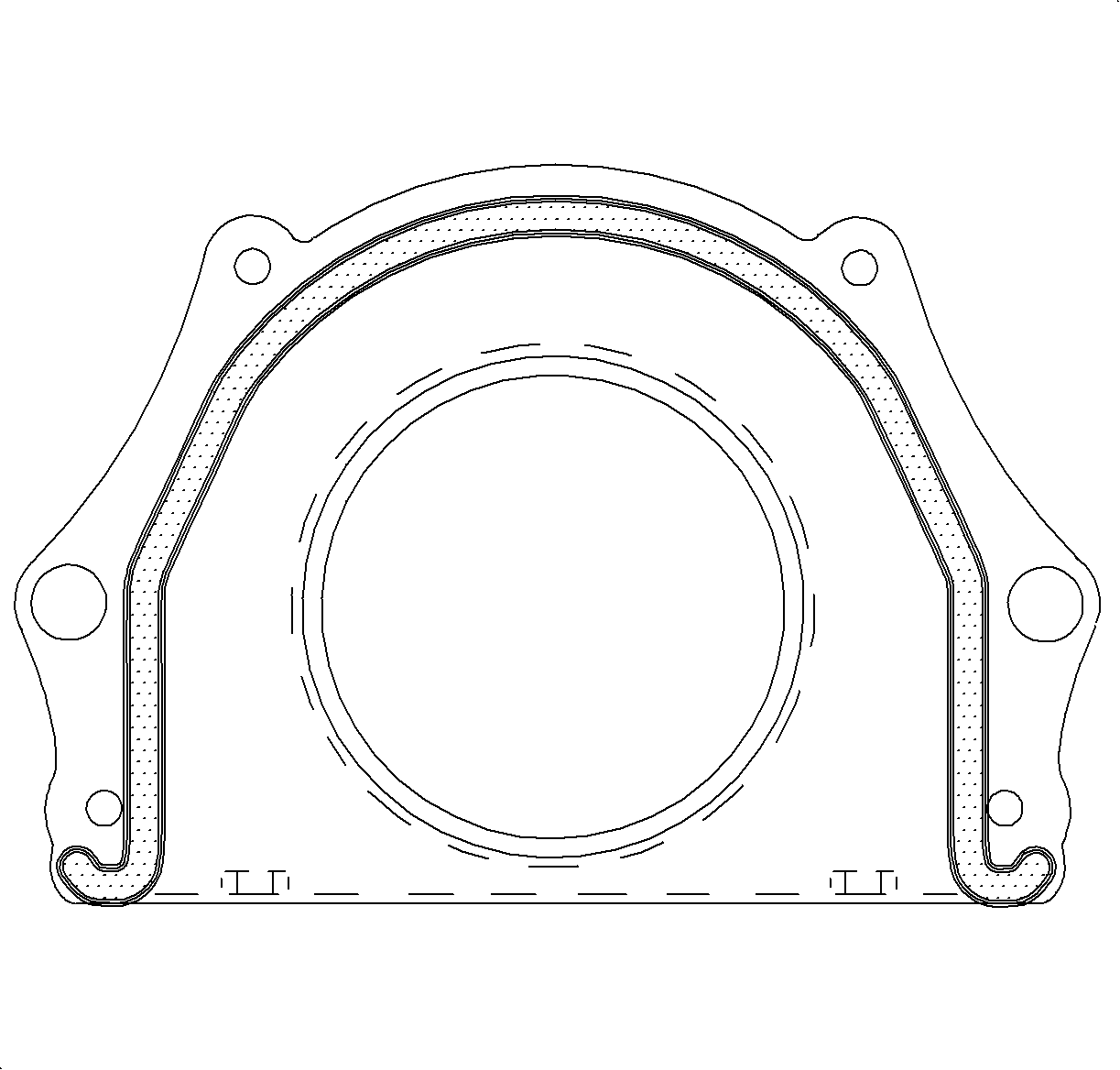
Important: Assemble while RTV is still wet, within 3 minutes. Do not wait for the RTV to skin over.
Tighten
Tighten the crankshaft rear oil seal assembly-to-block to 11 N·m
(97 lb in).
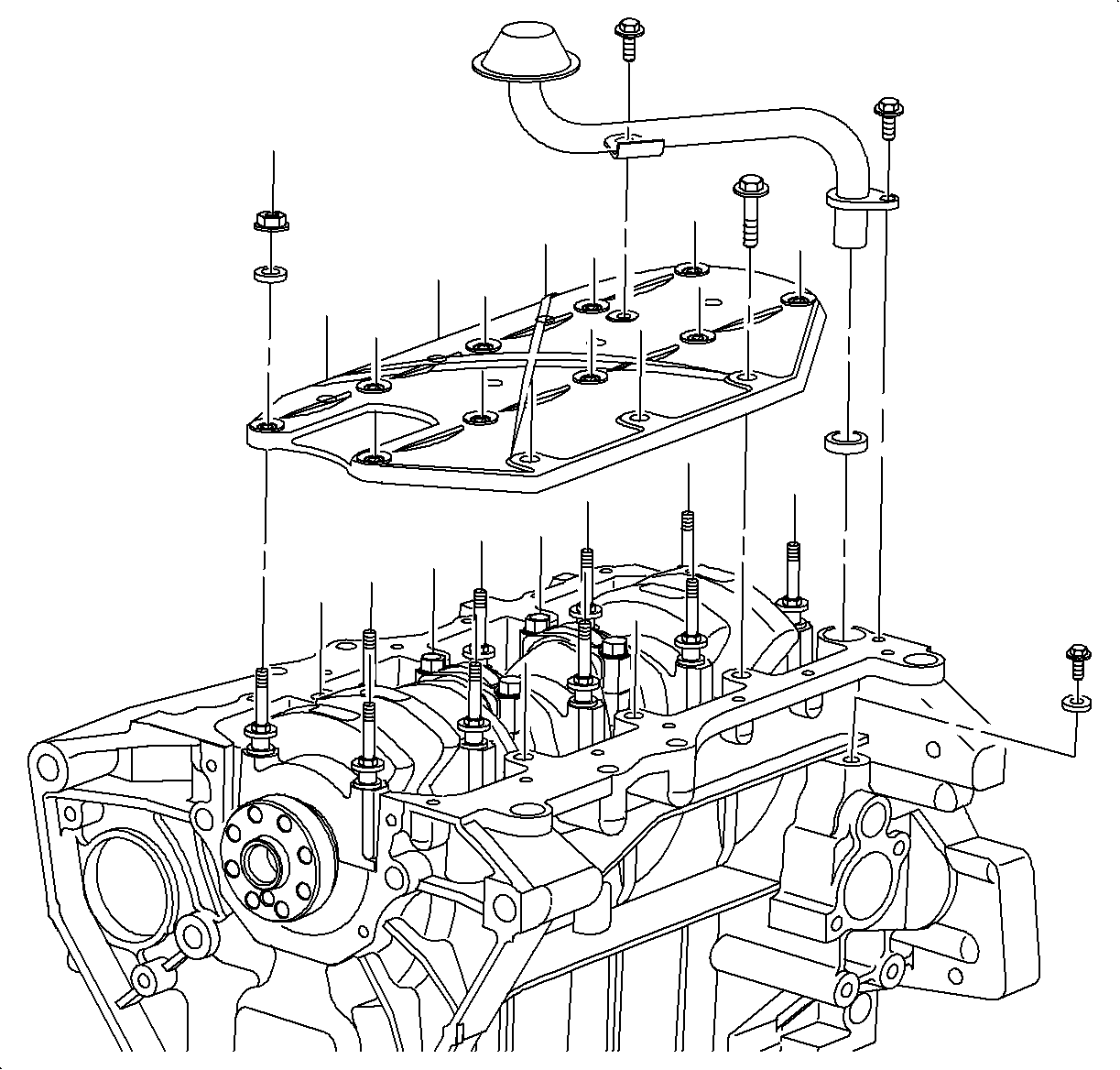
Important: Check the components for debris. Clean all parts before installation.

Important: Prior to assembly to the engine, tie-plate inserts must be rotated counterclockwise to recess the inserts within the tie plate. Failure to follow this procedure could result in tie-plate fracture and could cause engine damage.
Important: The tie-plate is assembled to the engine with the large rectangular opening located at rear of engine.
Tighten
Tighten the crankshaft bearing tie plate-to-oil pan rail to 55 N·m
(41 lb ft).
Tie Plate to oil pan rail torque sequence:
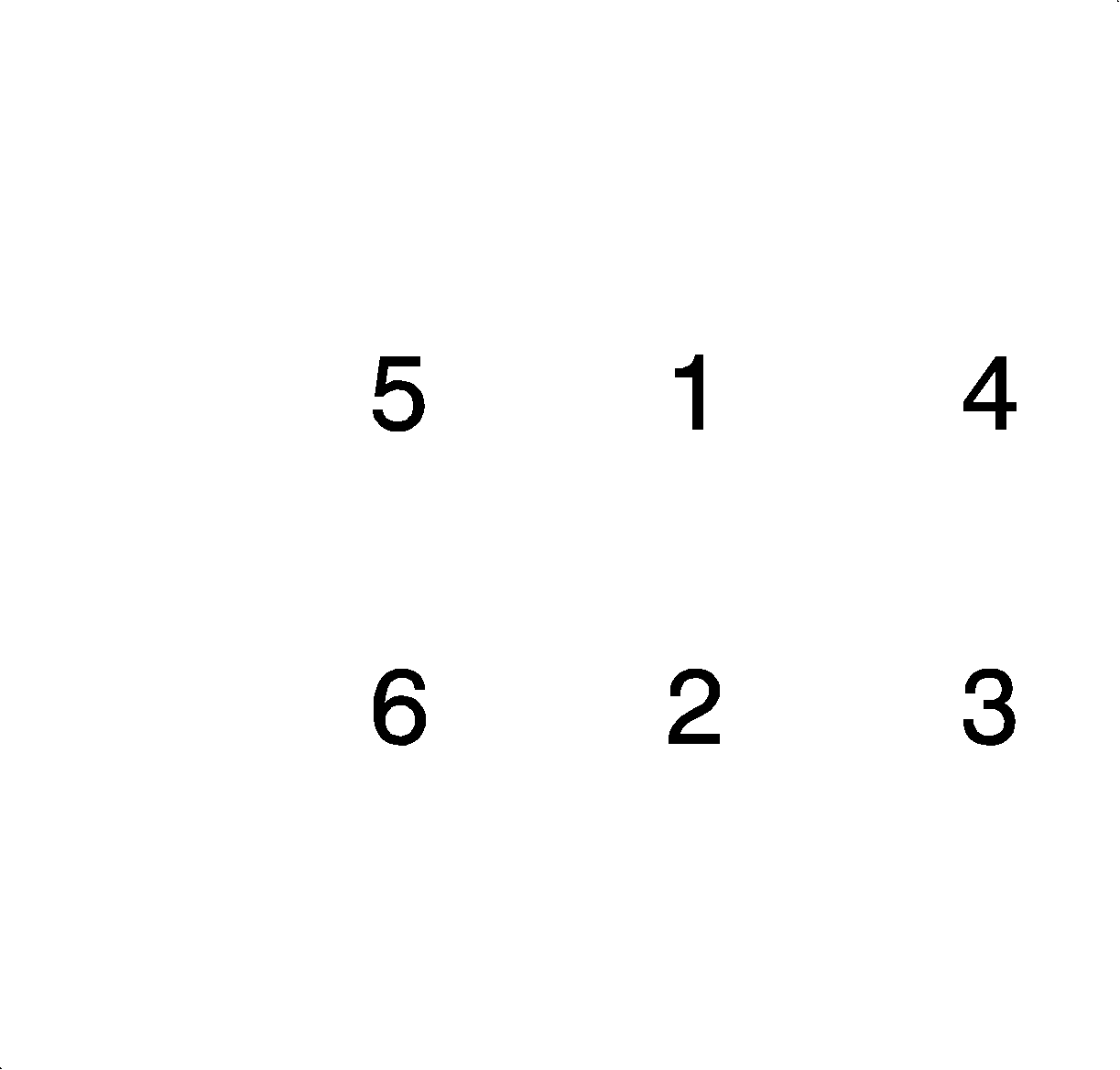

Important: Replace tie-plate washers with new washers when assembling tie-plate to engine.
Tighten
Tighten the crankshaft bearing tie plate insert to 3.5 N·m (31 lb in).
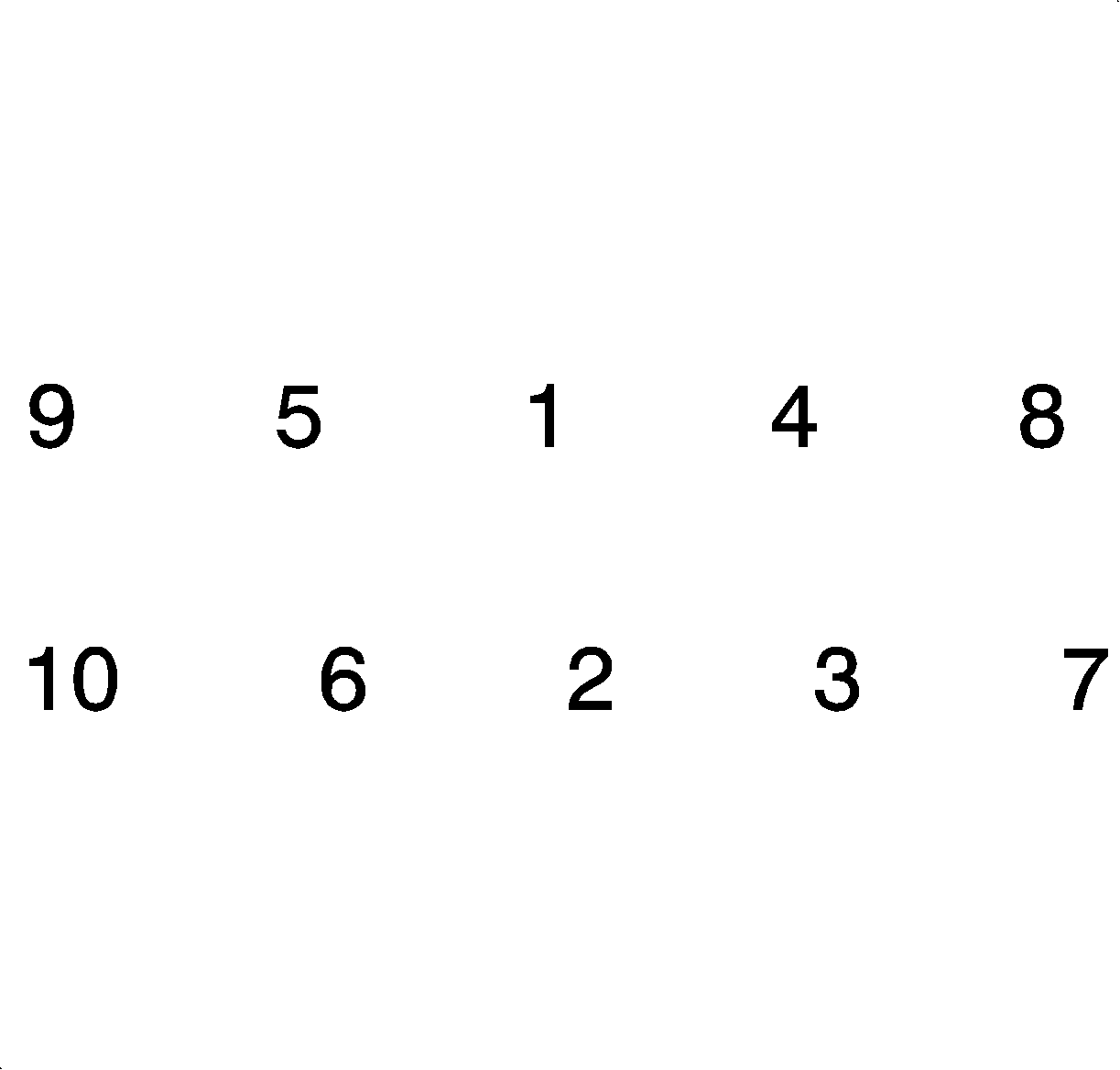

Tighten
Tighten the Crankshaft Bearing Tie Plate 25 N·m (18 lbs ft).
Torque sequence:

Tighten
| • | Tighten the oil pickup tube-to-block to 15 N·m (11 lb ft). |
| • | Tighten the oil pickup tube bracket-to-tie plate to 15 N·m (11 lb ft). |
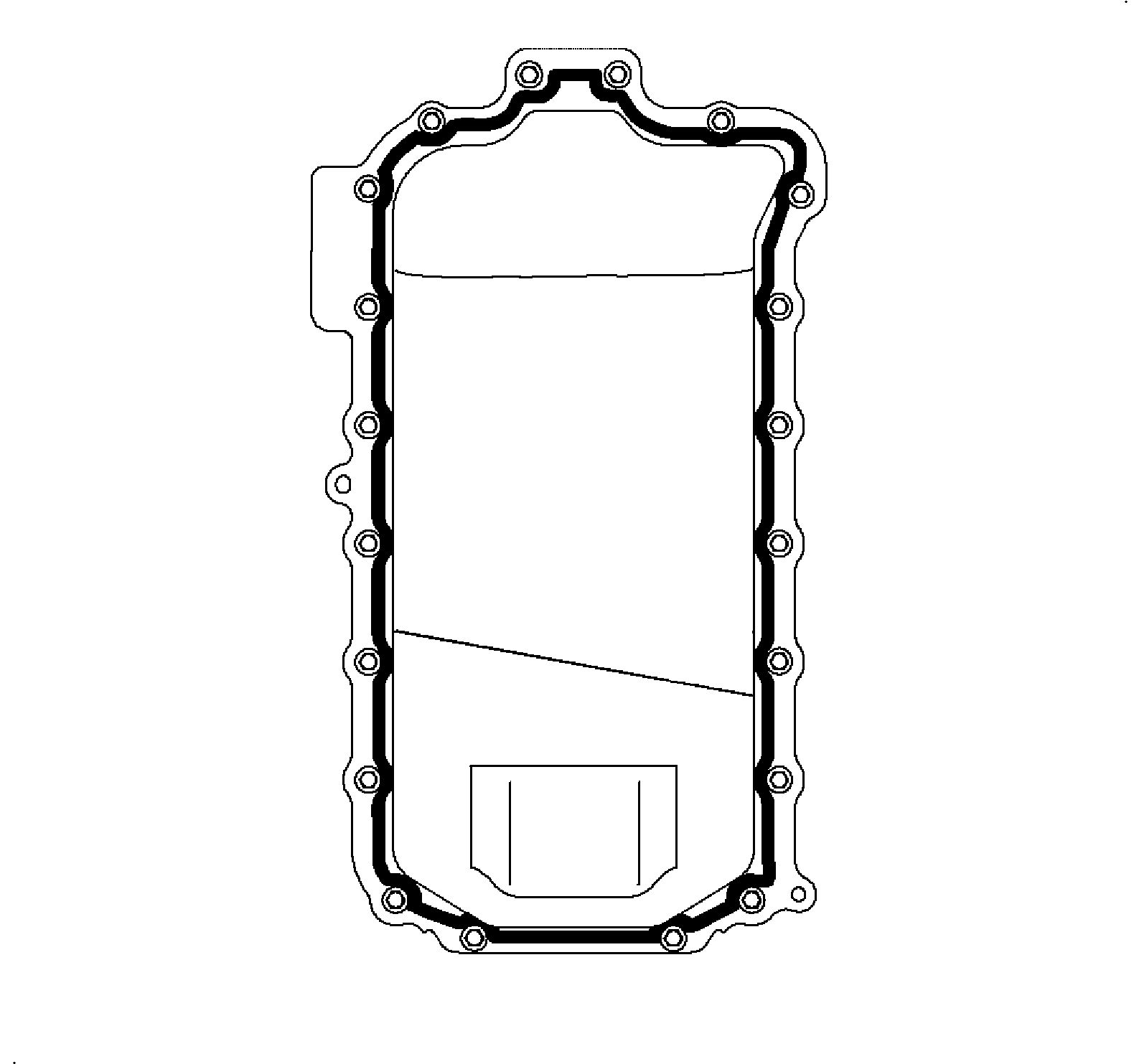
Important: The oil pan is easier to install after front cover assembly installation.
Important: Assemble while the RTV is still wet, within 3 minutes. Do not wait for the RTV to skin over.
Tighten
Tighten the oil pan-to-block to 9 N·m (80 lb in).
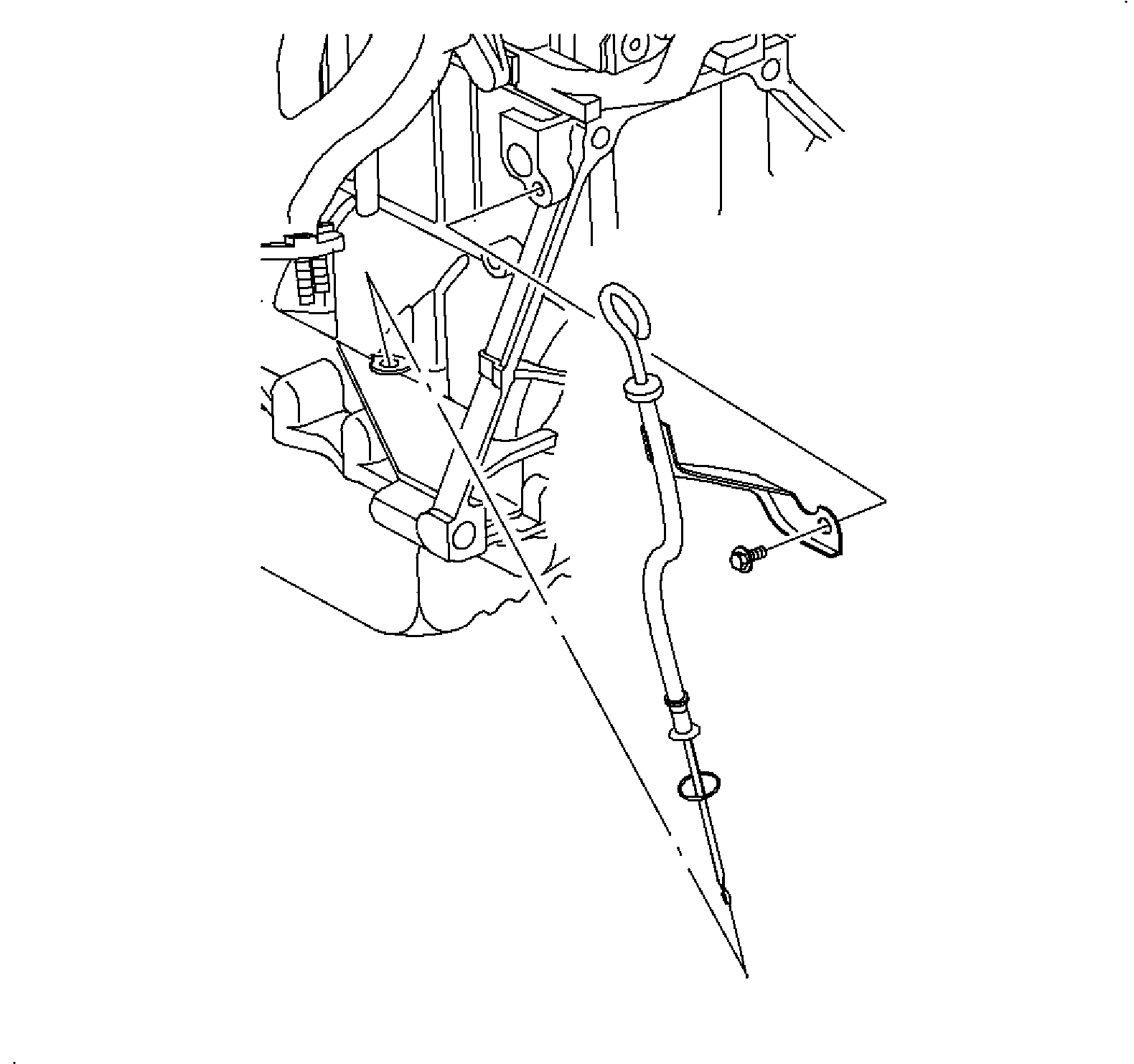
Install a new gasket. Use a small amount of RTV in three or four spots around the outer bolt holes to hold the gasket in place. Refer to the Cooling System section for water pump installation.
Tighten
| • | Tighten the water pump-to-block to 30 N·m (22 lb ft). |
| • | Tighten the water pump pulley-to-water pump hub to 25 N·m (19 lb ft). |
Tighten
Tighten the oil level indicator tube-to-block to 30 N·m (22 lb ft).
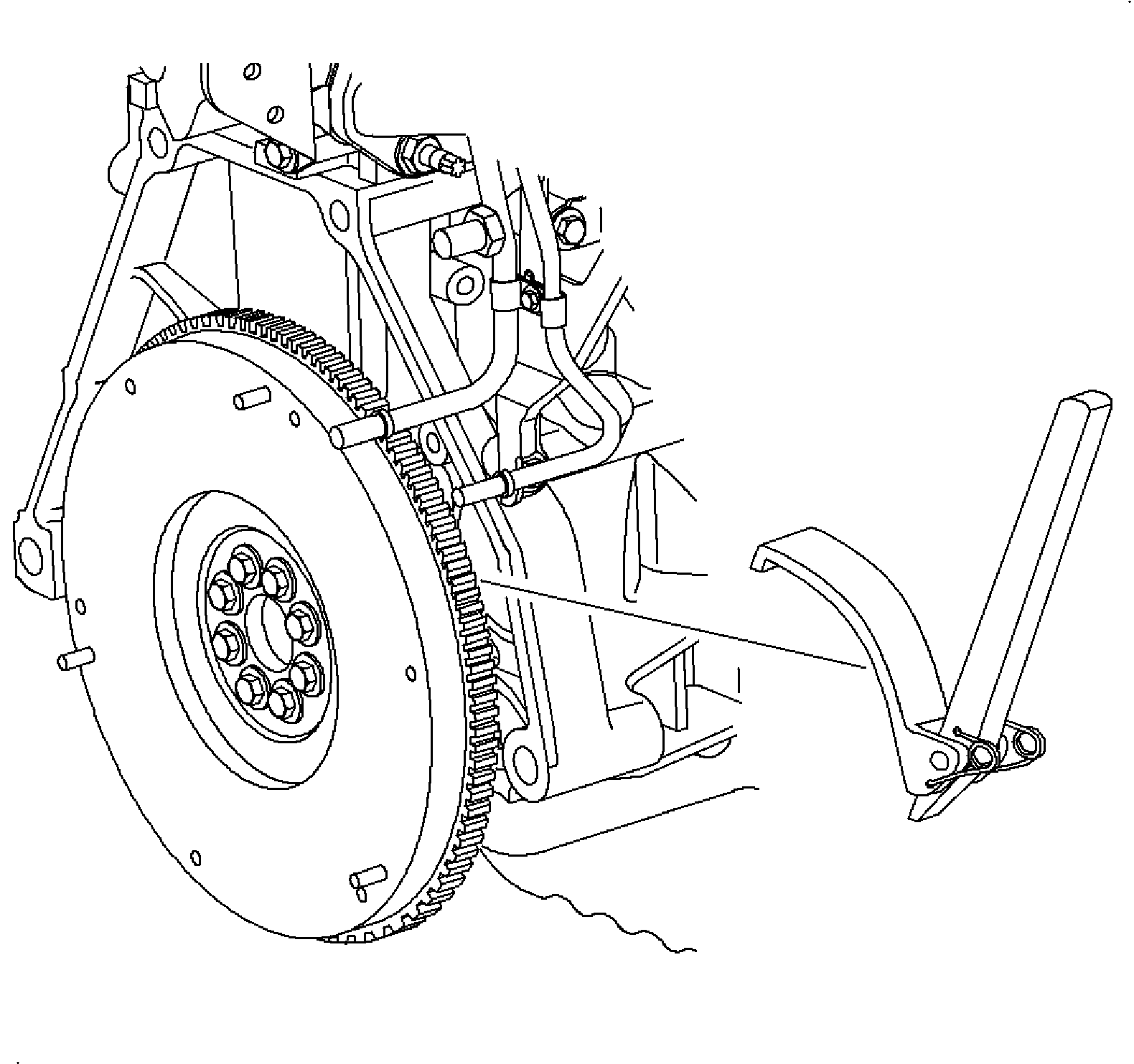
| • | Flexplate to crankshaft |
Tighten
Tighten the flexplate-to-crankshaft to 60 N·m (44 lb ft).
| • | Flywheel to crankshaft |
Tighten
Tighten the flywheel-to-crankshaft to 80 N·m (59 lb ft).
| • | The knock sensor |
Tighten
Tighten the knock sensor to 25 N·m (19 lb ft).
| • | The crankshaft position sensor. Lubricate the O-ring with oil before installation. |
Tighten
Tighten the crankshaft position sensor to 9 N·m (80 lb in).
| • | The starter motor to block. |
Tighten
Tighten the starter motor-to-block to 37 N·m (27 lb ft).
| Important: Whenever the cylinder block has been disassembled or the oil pump is removed, fill the oil cavity under the oil filter with clean engine oil to prime the pump. The oil pump must also be packed with petroleum jelly as outlined in the Lubrication System section. |
| • | The generator |
Tighten
Tighten the generator bolts to 32 N·m (24 lb ft).
| • | The oil filter |
Tighten
Tighten the gasket to contact and then 3/4-1 turn.
| • | The oil pan drain plug |
Tighten
Tighten the oil pan drain plug to 37 N·m (27 lb ft).
| • | The oil pressure sending unit |
Tighten
Tighten the oil pressure sending unit to 45 N·m (33 lb ft).
